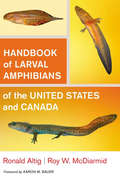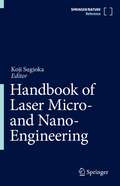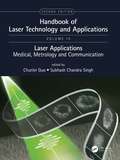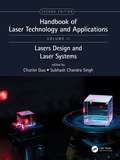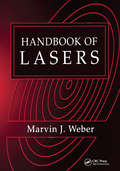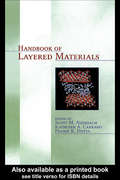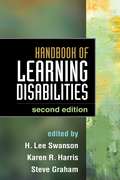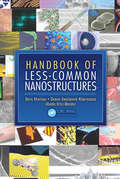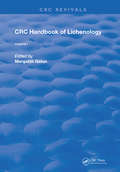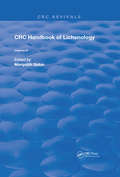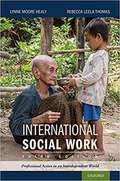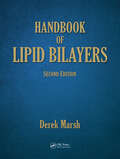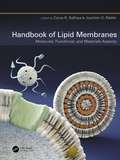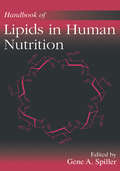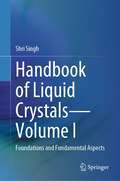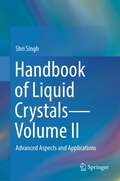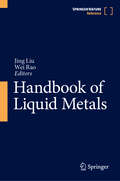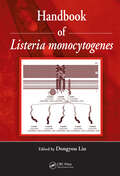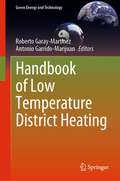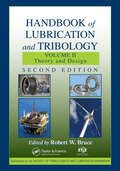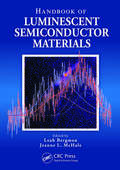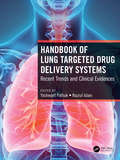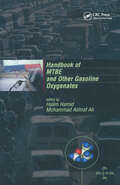- Table View
- List View
Handbook of Larval Amphibians of the United States and Canada
by Ronald Altig Roy W. Mcdiarmid Aaron M. BauerGenerously illustrated, this essential handbook for herpetologists, ecologists, and naturalists features comprehensive keys to eggs, embryos, salamander larvae, and tadpoles; species accounts; a glossary of terms; and an extensive bibliography. The taxonomic accounts include a summarization of the morphology and basic natural history, as well as an introduction to published information for each species. Tadpole mouthparts exhibit major characteristics used in identifications, and the book includes illustrations for a number of species. Color photographs of larvae of many species are also presented. Handbook of Larval Amphibians of the United States and Canada, written by the foremost experts on larval amphibians, is the first guide of its kind and will transform the fieldwork of scientists and fish and wildlife professionals.
Handbook of Laser Micro- and Nano-Engineering
by Koji SugiokaThis handbook provides a comprehensive review of the entire field of laser micro and nano processing, including not only a detailed introduction to individual laser processing techniques but also the fundamentals of laser-matter interaction and lasers, optics, equipment, diagnostics, as well as monitoring and measurement techniques for laser processing. Consisting of 11 sections, each composed of 4 to 6 chapters written by leading experts in the relevant field. Each main part of the handbook is supervised by its own part editor(s) so that high-quality content as well as completeness are assured. The book provides essential scientific and technical information to researchers and engineers already working in the field as well as students and young scientists planning to work in the area in the future. Lasers found application in materials processing practically since their invention in 1960, and are currently used widely in manufacturing. The main driving force behind this fact is that the lasers can provide unique solutions in material processing with high quality, high efficiency, high flexibility, high resolution, versatility and low environmental load. Macro-processing based on thermal process using infrared lasers such as CO2 lasers has been the mainstream in the early stages, while research and development of micro- and nano-processing are becoming increasingly more active as short wavelength and/or short pulse width lasers have been developed. In particular, recent advances in ultrafast lasers have opened up a new avenue to laser material processing due to the capabilities of ultrahigh precision micro- and nanofabrication of diverse materials. This handbook is the first book covering the basics, the state-of-the-art and important applications of the dynamic and rapidly expanding discipline of laser micro- and nanoengineering. This comprehensive source makes readers familiar with a broad spectrum of approaches to solve all relevant problems in science and technology. This handbook is the ultimate desk reference for all people working in the field.
Handbook of Laser Technology and Applications: Laser Applications: Medical, Metrology and Communication (Volume Four) (Handbook of Laser Technology and Applications #4)
by Chunlei Guo Subhash Chandra SinghThis comprehensive handbook gives a fully updated guide to lasers and laser technologies, including the complete range of their technical applications. This forth volume covers laser applications in the medical, metrology and communications fields. Key Features: • Offers a complete update of the original, bestselling work, including many brand-new chapters. • Deepens the introduction to fundamentals, from laser design and fabrication to host matrices for solid-state lasers, energy level diagrams, hosting materials, dopant energy levels, and lasers based on nonlinear effects. • Covers new laser types, including quantum cascade lasers, silicon-based lasers, titanium sapphire lasers, terahertz lasers, bismuth-doped fiber lasers, and diode-pumped alkali lasers. • Discusses the latest applications, e.g., lasers in microscopy, high-speed imaging, attosecond metrology, 3D printing, optical atomic clocks, time-resolved spectroscopy, polarization and profile measurements, pulse measurements, and laser-induced fluorescence detection. • Adds new sections on laser materials processing, laser spectroscopy, lasers in imaging, lasers in environmental sciences, and lasers in communications. This handbook is the ideal companion for scientists, engineers, and students working with lasers, including those in optics, electrical engineering, physics, chemistry, biomedicine, and other relevant areas.
Handbook of Laser Technology and Applications: Laser Design and Laser Systems (Volume Two) (Handbook of Laser Technology and Applications #2)
by Chunlei Guo Subhash Chandra SinghThis comprehensive handbook gives a fully updated guide to lasers and laser systems, including the complete range of their technical applications. The first volume outlines the fundamental components of lasers, their properties and working principles. The second volume gives exhaustive coverage of all major categories of lasers, from solid-state and semiconductor diode to fiber, waveguide, gas, chemical, and dye lasers. The third volume covers modern applications in engineering and technology, including all new and updated case studies spanning telecommunications and data storage to medicine, optical measurement, defense and security, nanomaterials processing and characterization.
Handbook of Laser-Induced Breakdown Spectroscopy
by Leon J. Radziemski David A. CremersStarting from fundamentals and moving through a thorough discussion of equipment, methods, and techniques, the Handbook of Laser-Induced Breakdown Spectroscopy provides a unique reference source that will be of value for many years to come for this important new analysis method. The authors, with a total of over 60 years of experience in the LIBS method, use a combination of tutorial discussions ranging from basic principles up to more advanced descriptions along with extensive figures and photographs to clearly explain topics addressed in the text. In this second edition, chapters on the use of statistical analysis and advances in detection of weapons of mass destruction have been added. Tables of data related to analysis with LIBS have been updated. The Handbook of Laser-Induced Breakdown Spectroscopy, Second Edition:provides a thorough but understandable discussion of the basic principles of the method based on atomic emission spectroscopy, including recently available data leading to better characterization of the LIBS plasma;presents a discussion of the many advantages of the method along with limitations, to provide the reader a balanced overview of capabilities of the method;describes LIBS instrumentation ranging from basic set-ups to more advanced configurations;presents a comprehensive discussion of the different types of components (laser, spectrometers, detectors) that can be used for LIBS apparatuses along with suggestions for their use, as well as an up-to-date treatment of the newest advances and capabilities of LIBS instruments;presents the analytical capabilities of the method in terms of detection limits, accuracy, and precision of measurements for a variety of different sample types;discusses methods of sampling different media such as gases, liquids, and solids;presents an overview of some real-world applications of the method, with new emphasis on sampling of biologically and physically dangerous materials;provides an up-to-date list of references to LIBS literature along with the latest detection limits and a unique list of element detection limits using a uniform analysis method;provides annotated examples of LIBS spectra which can serve as references for the general reader and will be especially useful for those starting out in the field.
Handbook of Lasers: Theory, Methods, And Applications (Laser & Optical Science & Technology #18)
by Marvin J. WeberLasers continue to be an amazingly robust field of activity. Anyone seeking a photon source is now confronted with an enormous number of possible lasers and laser wavelengths to choose from, but no single, comprehensive source to help them make that choice.The Handbook of Lasers provides an authoritative compilation of lasers, their properties, and original references in a readily accessible form. Organized by lasing media-solids, liquids, and gases-each section is subdivided into distinct laser types. Each type carries a brief description, followed by tables listing the lasing element or medium, host, lasing transition and wavelength, operating properties, primary literature citations, and, for broadband lasers, reported tuning ranges.The importance and value of the Handbook of Lasers cannot be overstated. Serving as both an archive and as an indicator of emerging trends, it reflects the state of knowledge and development in the field, provides a rapid means of obtaining reference data, and offers a pathway to the literature. It contains data useful for comparison with predictions and for developing models of processes, and may reveal fundamental inconsistencies or conflicts in the data.
Handbook of Layered Materials
by Scott M. Auerbach Kathleen A. Carrado Prabir K. DuttaFocusing on layered compounds at the core of materials intercalation chemistry, this reference comprehensively explores clays and other classes of materials exhibiting the ability to pillar, or establish permanent intracrystalline porosity within layers. It offers an authoritative presentation of their fundamental properties as well as summaries of
Handbook of Learning Disabilities, Second Edition
by Steve Graham Karen R. Harris H. Lee SwansonWidely regarded as the standard reference in the field, this comprehensive handbook presents state-of-the-art knowledge about the nature and classification of learning disabilities (LD), their causes, and how individuals with these difficulties can be identified and helped to succeed. Best practices are described for supporting student performance in language arts, math, and other content areas. Contributors also identify general principles of effective instruction and review issues in service delivery within response-to-intervention (RTI) frameworks. The book critically examines the concepts and methods that guide LD research and highlights important directions for future investigation. New to This Edition: *Incorporates key advances in identifying and remediating LD, with particular attention to the role of RTI. *Chapters on social cognitive, behavioral genetic, and neurobiological aspects. *Chapters on adolescents and adults with LD. *Chapters on spelling instruction, history instruction, and classroom technology applications. *Chapter synthesizing 21st-century advances in LD research methods, plus chapters on advanced statistical models, single-case designs, and meta-analysis.
Handbook of Less-Common Nanostructures
by Boris I. Kharisov Oxana Vasilievna Kharissova Ubaldo Ortiz-MendezAs nanotechnology has developed over the last two decades, some nanostructures, such as nanotubes, nanowires, and nanoparticles, have become very popular. However, recent research has led to the discovery of other, less-common nanoforms, which often serve as building blocks for more complex structures.In an effort to organize the field, the Handbook of Less-Common Nanostructures presents an informal classification based mainly on the less-common nanostructures. A small nanotechnological encyclopedia, this book: Describes a range of little-known nanostructures Offers a unifying vision of the synthesis of nanostructures and the generalization of rare nanoforms Includes downloadable resources with color versions of more than 100 nanostructures Explores the fabrication of rare nanostructures, including modern physical, chemical, and biological synthesis techniques The Handbook of Less-Common Nanostructures discusses a classification system not directly related to the dimensionality and chemical composition of nanostructure-forming compounds or composite. Instead, it is based mainly on the less-common nanostructures. Possessing unusual shapes and high surface areas, these structures are potentially very useful for catalytic, medical, electronic, and many other applications.
Handbook of Lichenology: Volume 1 (Routledge Revivals)
by Margalith GalunFirst published in 1988: This easy-to-read handbook provides a comprehensive review of the current knowledge on lichens. The structure of lichens and their dual nature is explained, as well as the physiology of interaction of the symbionts. The way lichens reproduce and their ecology is included, with methods for cultivating them and their isolated symbionts. Extremely useful as a text of lichenology, this handbook will benefit students of lichenology and allied fields, those interested in symbiotic associations and ecology, and teachers of biology, botany, and ecology courses.
Handbook of Lichenology: Volume 3 (Routledge Revivals)
by Margalith GalunFirst published in 1988: This easy-to-read handbook provides a comprehensive review of the current knowledge on lichens. The structure of lichens and their dual nature is explained, as well as the physiology of interaction of the symbionts. The way lichens reproduce and their ecology is included, with methods for cultivating them and their isolated symbionts. Extremely useful as a text of lichenology, this handbook will benefit students of lichenology and allied fields, those interested in symbiotic associations and ecology, and teachers of biology, botany, and ecology courses.
Handbook of Life-Span Development
by Karen L. Fingerman Jacqui Smith Cynthia A. Berg Toni C. AntonucciThe doubling of our average life span since the turn of the 20th century is considered by many scholars to be one of the most important changes in human existence. This definitive text is the only volume to fully address, through a multidisciplinary perspective, the biological, cognitive, and psychological development that occurs from infancy through old age, and how the sociocultural and institutional factors interface with these changes. <p><p> Edited by leading research scholars in the field of life-span development, the volume also includes contributions of specialists in behavioral genetics, socioemotional selectivity theory, neuroscience, ecological models, and more. It examines the dynamics of close relationships and informal ties among the elderly population, child-parent attachment relationships as a life-span phenomenon, developmental tasks across the lifespan, continuity and discontinuity in temperament and personality, the sociocultural context of cognition across the life span, and variability in approaches to social problem solving from early to later life. Given the number of recent demographic shifts, it also explores issues related to fertility, life expectancy, environmental contexts, technology, immigration, and public policy.
Handbook of Lipid Bilayers
by Derek MarshNow in its second edition, the Handbook of Lipid Bilayers is a groundbreaking work that remains the field's definitive text and only comprehensive source for primary physicochemical data relating to phospholipid bilayers. Along with basic thermodynamic data, coverage includes both dynamic and structural properties of phospholipid bilayers. It is an
Handbook of Lipid Membranes: Molecular, Functional, and Materials Aspects
by Cyrus R. Safinya Joachim O. RädlerThis handbook provides a unique overview of lipid membrane fundamentals and applications. The fascinating world of lipids that harbor and govern so many biological functionalities are discussed within the context of membrane structures, interactions, and shape evolution. Beyond the fundamentals in lipid science, this handbook focuses on how scientists are building bioinspired biomimetic systems for applications in medicine, cosmetics, and nanotechnology. Key Features: Includes experimental and theoretical overviews on the role of lipids, with or without associated biomolecules, as structural components imparting distinct membrane shapes and intermembrane interactions Covers the mechanisms of lipid-membrane curvature, by peptide and protein binding, and the roles of signalling lipids and the cytoskeleton in plasma membrane shape evolution Covers advanced X-ray and force measurement techniques Discusses applications in biomedicine, cosmetics, and nanotechnology, including lipid vectors in nucleic acid, drug delivery in dermal applications, and lipid-based sensors and artificial biointerfaces Covers artificial membranes from block copolymers, synthetic copolypeptides, and recombinant proteins Includes an exciting section that explores the role of lipids in the origin of life in hydrothermal conditions This book is a highly informative companion for professionals in biophysics, biochemistry, physical chemistry, and material and pharmaceutical sciences and bioengineering.
Handbook of Lipids in Human Nutrition
by Gene A. SpillerThe Handbook of Lipids in Human Nutrition is a concise reference for professionals and students interested in the role of lipids in nutrition. Over 100 tables and illustrations provide quick access to the most current data available.
Handbook of Liquid Crystals—Volume I: Foundations and Fundamental Aspects
by Shri SinghThis expert and self-contained authored handbook provides comprehensive coverage of liquid crystals from the fundamental materials science, physics, and modeling through cutting-edge applications. Written by an author with over 40 years of active experience in this growing field, it offers an unprecedented self-contained treatment of this key research area.Liquid Crystals are a state of matter sharing properties that are usually associated with both solids and liquids. Their study belongs to wider field of soft condensed matter physics, an area growing in importance because of the new physics being discovered and the possibilities of various technological applications being developed. Liquid crystals continue to have a revolutionary technological impact and consistently pose new challenges of basic understanding. While the experimental side of liquid crystal research is very well developed, theoretical understanding has lagged, and this volume fills a gap in thepublished literature in terms of rigorous treatment of mathematical and computer modeling approaches.Volume I of this handbook deals with the physical foundations and fundamental aspects of liquid crystals, addressing their physical properties, measurement techniques, and various types. Overall, this handbook serves as the ultimate scholarly guide for researchers, scientists, and engineers seeking to unlock the full potential of liquid crystals. It offers a comprehensive understanding of these materials and their diverse applications, empowering readers to navigate the complex intricacies of liquid crystal science and technology.
Handbook of Liquid Crystals—Volume II: Advanced Aspects and Applications
by Shri SinghThis expert and self-contained authored handbook provides comprehensive coverage of liquid crystals from the fundamental materials science, physics, and modeling through cutting-edge applications. Written by an author with over 40 years of active experience in this growing field, it offers an unprecedented self-contained treatment of this key research area.Liquid Crystals are a state of matter sharing properties that are usually associated with both solids and liquids. Their study belongs to wider field of soft condensed matter physics, an area growing in importance because of the new physics being discovered and the possibilities of various technological applications being developed. Liquid crystals continue to have a revolutionary technological impact and consistently pose new challenges of basic understanding. While the experimental side of liquid crystal research is very well developed, theoretical understanding has lagged, and this volume fills a gap in the published literature in terms of rigorous treatment of mathematical and computer modeling approaches.Volume II of this handbook deals with advanced aspects of liquid crystals and their applications, covering computer simulations of phase transitions in liquid crystals, liquid crystals of biomolecules, and defect textures in liquid crystals. Overall, this handbook serves as the ultimate scholarly guide for researchers, scientists, and engineers seeking to unlock the full potential of liquid crystals. It offers a comprehensive understanding of these materials and their diverse applications, empowering readers to navigate the complex intricacies of liquid crystal science and technology.
Handbook of Liquid Metals
by Jing Liu Wei RaoThis handbook systematically collects the latest scientific and technological knowledge on liquid metals obtained so far in this cutting edge frontier. Conventional materials such as metals, polymers, composites, ceramics and naturally derived matters, may not perform well when facing certain technological challenges. At around room temperature, most of such materials mainly stay at solid state and are often difficult to shape due to their high melting point. Meanwhile, although classical soft matters own good flexibility, their electrical conductivities including more behaviours appear not good enough which generally limited their utilizations. As a game-changing alternative, the room temperature liquid metal materials are quickly emerging as a new generation functional material which displayed many unconventional properties superior to traditional materials. Their outstanding versatile feature as “One material, diverse capabilities” is rather unique among existing materials and thus opens many exciting opportunities for scientific, technological and industrial developments. This handbook presents comprehensive reference information on liquid metal science and technology that are currently available. The major advancements as made before are collected and summarized. Representative liquid metal applications are illustrated. It helps readers obtain a comprehensive understanding of the technical progresses and fundamental discoveries in the frontier, and thus better explore and utilize liquid metal materials to address various challenging needs.
Handbook of Listeria Monocytogenes
by Dongyou LiuOnce feared as a deadly intracellular bacterium with the extraordinary capacity to survive a wide array of arduous external stressors, Listeria monocytogenes is increasingly recognized as a preferred vector for delivering anti-infective and anti-cancer vaccine molecules. A reliable, single-source reference on the fundamental aspects of
Handbook of Low Temperature District Heating (Green Energy and Technology)
by Roberto Garay-Martinez Antonio Garrido-MarijuanThis book reviews the history and evolution of district heating networks, with a focus on current and future issues of the district heating sector. Novel developments in the field of low temperature district heating are studied, limitations for safe operation and avoidance of bacteria are considered, and the associated improved performance of the system with fewer network losses is presented.This book showcases how the evolution of district heating networks is linked to the increased use of renewables and de-carbonized heat sources with specific focus to waste heat streams and solar energy systems. Considering the novelty of these technologies, technological developments and funding schemes for these investments are still immature to some extent. For that reason, a comprehensive review of the main aspects of energy planning as well as district heating economics and financing schemes for large-scale investments in renewable energy systems for district energy systems is performed.In the light of digitalization, networks are increasingly monitored, allowing for a drastic change in the approach for network operation. This book also explores the increased digitization and monitoring of networks and how this impacts network operation.This book is of interest to engineers, academics and officials interested in energy systems, presenting readers with the key concepts and tools to adapt to the evolution of district heating into an integrated, digitized and higher performing system.
Handbook of Lubrication and Tribology, Volume II: Theory and Design, Second Edition
by Robert W. BruceSince the publication of the best-selling first edition, the growing price and environmental cost of energy have increased the significance of tribology. Handbook of Lubrication and Tribology, Volume II: Theory and Design, Second Edition demonstrates how the principles of tribology can address cost savings, energy conservation, and environmental pr
Handbook of Luminescent Semiconductor Materials
by Jeanne L. McHale Leah BergmanPhotoluminescence spectroscopy is an important approach for examining the optical interactions in semiconductors and optical devices with the goal of gaining insight into material properties. With contributions from researchers at the forefront of this field, Handbook of Luminescent Semiconductor Materials explores the use of this technique to stud
Handbook of Lung Targeted Drug Delivery Systems: Recent Trends and Clinical Evidences
by Yashwant PathakHandbook of Lung Targeted Drug Delivery Systems: Recent Trends and Clinical Evidences covers every aspect of the drug delivery to lungs, the physiology and pharmacology of the lung, modelling for lung delivery, drug devices focused on lung treatment, regulatory requirements, and recent trends in clinical applications. With the advent of nano sciences and significant development in the nano particulate drug delivery systems there has been a renewed interest in the lung as an absorption surface for various drugs. The emergence of the COVID-19 virus has brought lung and lung delivery systems into focus, this book covers new developments and research used to address the prevention and treatment of respiratory diseases. Written by well-known scientists with years of experience in the field this timely handbook is an excellent reference book for the scientists and industry professionals. Key Features: Focuses particularly on the chemistry, clinical pharmacology, and biological developments in this field of research. Presents comprehensive information on emerging nanotechnology applications in diagnosing and treating pulmonary diseases Explores drug devices focused on lung treatment, regulatory requirements, and recent trends in clinical applications Examines specific formulations targeted to pulmonary systems
Handbook of MTBE and Other Gasoline Oxygenates
by Halim Hamid Mohammad Ashraf AliThis handbook presents the outlook for future production and consumption of MTBE and other oxygenates worldwide and studies new catalytic systems and modern methods for the synthesis and commercial production of methyl tertiary-butyl ether (MTBE) and related ethers. The scope of this sophisticated guide extends from process chemistry fundamentals a
Handbook of Machine Learning Applications for Genomics (Studies in Big Data #103)
by Sanjiban Sekhar Roy Y. H. TaguchiCurrently, machine learning is playing a pivotal role in the progress of genomics. The applications of machine learning are helping all to understand the emerging trends and the future scope of genomics. This book provides comprehensive coverage of machine learning applications such as DNN, CNN, and RNN, for predicting the sequence of DNA and RNA binding proteins, expression of the gene, and splicing control. In addition, the book addresses the effect of multiomics data analysis of cancers using tensor decomposition, machine learning techniques for protein engineering, CNN applications on genomics, challenges of long noncoding RNAs in human disease diagnosis, and how machine learning can be used as a tool to shape the future of medicine. More importantly, it gives a comparative analysis and validates the outcomes of machine learning methods on genomic data to the functional laboratory tests or by formal clinical assessment. The topics of this book will cater interest to academicians, practitioners working in the field of functional genomics, and machine learning. Also, this book shall guide comprehensively the graduate, postgraduates, and Ph.D. scholars working in these fields.
